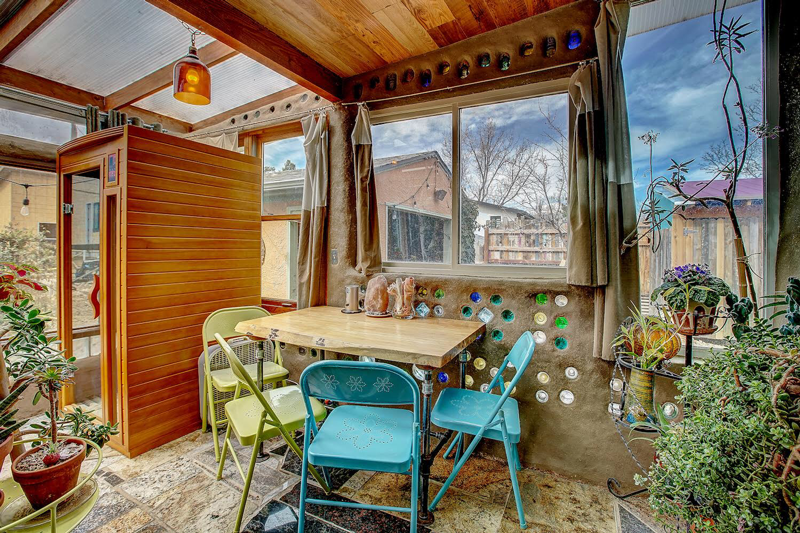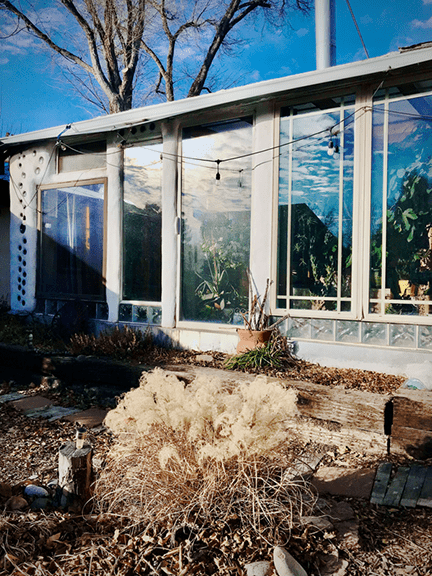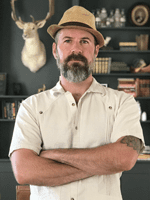Somewhere in my subconscious, I believe I was driven by a Thoreau-like obsession to live deliberately. More in the forefront of my mind, I knew I was inspired by Earthships when I endeavored to add onto my modest 740-square-foot home in Colorado Springs, Colorado.
I’m located just outside the city center, in a quiet neighborhood composed mostly of austere, square homes built in the 1950s. A typical urban grid, well inside of strict city zoning boundaries, where no alternative building is present and even the notion of more accessory dwelling units (ADUs) caused a kerfuffle in local council meetings in recent years.
How was I to do something different? To skirt convention while adhering to code? But construct something reflective of my environmental ethos, incorporating reclaimed materials, passive solar and an artistic aesthetic informed by natural objects?
The answer: Create an attached, sunroom/greenhouse with typical framing and glazing, but all things alternatively allowable from there onward, such as both earth and stone flooring, as well as thick mud walls, hand formed around burned wood tree trunks, and light-gifting bottle bricks (cut wine bottle punts taped together to create colorful glass circles). Make it a space both for growing food (today there’s a mature fig tree fat with fruit) and living. Dining at a custom-built, wormy maple wood table; gardening indoors with cacti, succulents, tropical and carnivorous plants; resting on a lounging bed adjacent to a wood-burning stove for winter; and sweating in a far-infrared sauna with a view out over the back garden where my ducks quack about.
Back to the beginning. I first visited Taos, New Mexico, less than a four-hour drive from the Springs, in the summer of 1997 while a freshman at Colorado College (CC). Taos being home to architect Michael Reynolds’ now-internationally recognized Earthships, and CC being the type of hippie-dippy, liberal arts school where field classes (like anthropology) on the block plan (intensive three-and-a-half week classes versus semester programming) would include roadside stops to places like Earthship Biotecture, a self-sufficient, eco-living community located on a high mesa, not far from the stunning Rio Grande Gorge Bridge, which rises 600 feet above the famed river.


Gorgeous photos of the greenie commune can be seen on Earthship Biotecture, which teaches both short seminars and hosts a longer educational academy on Earthship building. It also sells construction plans for the DIY crowd. To describe an earthship is somewhat to suggest the literal interpretation of the portmanteau: Picture the mass of a beached boat buried half in the earth, with rammed-earth tire walls for thermal mass and plaster walls composed with densely packed bottles and aluminum cans. Trash, turned to treasure. A vehicle to a better future.
I did not attend any studies on site, but for years after that first visit, and subsequent others, I remained fascinated by the designs. So, when I approached my home renovation, I wanted something like an earthship, at least visually and as functionally as possible. (For example, I wouldn’t be operating off-grid, but I could harvest the sun’s power to help heat my home).
So here’s what I did as my own project manager: I hired a sustainability-minded architect/structural engineer for my plans; utilized a basic framer and roofer to execute the bones (that is, after hand-digging giant holes and laying our own foundation); paid lots of friend helpers in cash, beer and pizza; and made a mud buddy (founder/operator of Colorado Cob Company) for advisement on and co-execution of the earthen walls (just sand, straw, clay and natural finishing plasters made with everything from horse poop to rendered prickly pear juice).
Over the course of 2014 and 2015, in just about all of my spare time outside of my demanding journalism day job, my misfit crew and I gave structure to my dream and created a living space that’s a perpetual glamping trip in terms of its blend of modern convenience and natural wonder.


My local Habitat for Humanity ReStore proved invaluable. Mismatched scraps of laminate flooring became a ceiling in an inspired case of the upside-downs (er, um, downside-ups). Remnant stone pieces – leftovers from affluent-area countertop installations – became an angular floor mosaic (of granites, marble and even labradorite) on my upper living area, under which I buried PEX tubing for supplemental heat when (rarely) needed. The lower gardening zone connects directly to the earth, and raised beds allow gardening at waist-height with incredible sun exposure that has even my jade tree blooming annually with pretty white flower clusters.
All my windows came via the ReStore, too, and aside from the necessary commercial lumber from big-box stores for cross-framing, we harvested our own trees off nearby land scorched in the 2012 Waldo Canyon Fire. Those became central support posts, and we turned one twisted juniper tree into an ornamental wall installation, branches “growing” out into the room’s head space. I left the black, charred bark, to tell a separate, longer story, one I’ll summarize here by saying that the fire started when I was bed-bound in a hospital from being hit on my motorcycle. Doped up and laid out, I watched the Front Range hillside below Pikes Peak burn orange through the night over our city. Years later, when I finally obtained my legal settlement, it paid for this renovation, which I never could have afforded previously. Something beautiful, out of the ashes, good from bad. Something meaningful to me. Something deliberate.


Several years after this greenhouse addition, I installed solar photovoltaic panels on my adjacent garage, which I converted into a cozy cottage for short-term rental. I also began renting my second, main house bedroom on Airbnb, which allows me to share the greenhouse – accessible through my kitchen – with guests, who’re always so gracious with their admiration of it. They love the sound of a water fountain, audibly texturing the visual plant splendor, my mini jungle, my wild interior, my sunny respite, my living room.
It’s not quite a real Earthship, but it’s the best I can do inside the city, and the energy savings have been significant. Ultimately, unlike Thoreau, I didn’t go into the woods; I brought them to me instead. At least a little slice of them, fused into my traditional abode. I would argue that in today’s America, so far advanced (sprawled and populated) from that colonial New England past, if we aim to live deliberately, we must do so unconventionally.
Matthew Schniper is a freelance journalist and the Food & Drink Editor/Critic at the Colorado Springs Independent. He’s also a podcaster, recently publishing two series: State of Plate, a study of the Springs’ food scene; and Vulnerable Creatures, a true-crime and systems change story of a young man with autism accused of animal cruelty.



